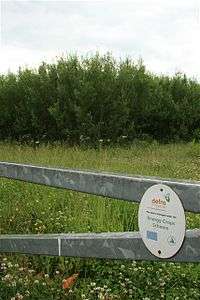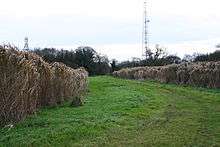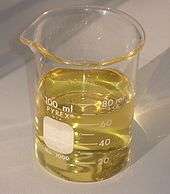Energy crop
Energy crops are low-cost and low-maintenance crops grown solely for energy production by combustion (not for food). The crops are processed into solid, liquid or gaseous fuels, such as pellets, bioethanol or biogas. The fuels are burned to generate electrical power or heat.

The plants are generally categorized as woody or herbaceous. Woody plants include willow[1] and poplar, herbaceous plants include Miscanthus x giganteus and Pennisetum purpureum (both known as elephant grass). Herbaceous crops, while physically smaller than trees, store roughly twice the amount of CO2 (in the form of carbon) below ground, compared to woody crops.[2]
Through biotechnological procedures such as genetic modification plants can be manipulated to create higher yields. Relatively high yields can also be realized with existing cultivars.[3]:250 However, some additional advantages such as reduced associated costs (i.e. costs during the manufacturing process[4] ) and less water use can only be accomplished by using genetically modified crops.
Types
Solid biomass

Solid biomass, often pelletized, is used for combustion in thermal power stations, either alone or co-fired with other fuels. Alternatively it may be used for heat or combined heat and power (CHP) production.
In short rotation coppice (SRC) agriculture, fast growing tree species like willow and poplar are grown and harvested in short cycles of three to five years. These trees grow best in wet soil conditions. An influence on local water conditions can not be excluded. Establishment close to vulnerable wetland should be avoided.[7][8][9]
Gas biomass (methane)
Whole crops such as maize, Sudan grass, millet, white sweet clover, and many others can be made into silage and then converted into biogas.[3] Anaerobic digesters or biogas plants can be directly supplemented with energy crops once they have been ensiled into silage. The fastest-growing sector of German biofarming has been in the area of "Renewable Energy Crops" on nearly 500,000 ha (1,200,000 acres) of land (2006).[10] Energy crops can also be grown to boost gas yields where feedstocks have a low energy content, such as manures and spoiled grain. It is estimated that the energy yield presently of bioenergy crops converted via silage to methane is about 2 GWh/km2 (1.8×1010 BTU/sq mi) annually. Small mixed cropping enterprises with animals can use a portion of their acreage to grow and convert energy crops and sustain the entire farm's energy requirements with about one-fifth of the acreage. In Europe and especially Germany, however, this rapid growth has occurred only with substantial government support, as in the German bonus system for renewable energy.[11] Similar developments of integrating crop farming and bioenergy production via silage-methane have been almost entirely overlooked in N. America, where political and structural issues and a huge continued push to centralize energy production has overshadowed positive developments.
Liquid biomass
Biodiesel


European production of biodiesel from energy crops has grown steadily in the last decade, principally focused on rapeseed used for oil and energy. Production of oil/biodiesel from rape covers more than 12,000 km² in Germany alone, and has doubled in the past 15 years.[12] Typical yield of oil as pure biodiesel is 100,000 L/km2 (68,000 US gal/sq mi; 57,000 imp gal/sq mi) or higher, making biodiesel crops economically attractive, provided sustainable crop rotations are used that are nutrient-balanced and prevent the spread of disease such as clubroot. Biodiesel yield of soybeans is significantly lower than that of rape.[13]
| Crop | Oil % |
|---|---|
| copra | 62 |
| castor seed | 50 |
| sesame | 50 |
| groundnut kernel | 42 |
| jatropha | 40 |
| rapeseed | 37 |
| palm kernel | 36 |
| mustard seed | 35 |
| sunflower | 32 |
| palm fruit | 20 |
| soybean | 14 |
| cotton seed | 13 |
Bioethanol
Two leading non-food crops for the production of cellulosic bioethanol are switchgrass and giant miscanthus. There has been a preoccupation with cellulosic bioethanol in America as the agricultural structure supporting biomethane is absent in many regions, with no credits or bonus system in place. Consequently, a lot of private money and investor hopes are being pinned on marketable and patentable innovations in enzyme hydrolysis and similar processes. Grasses are also energy crops for biobutanol.
Bioethanol also refers to the technology of using principally corn (maize seed) to make ethanol directly through fermentation. However, under certain field and process conditions this process can consume as much energy as is the energy value of the ethanol it produces, therefore being non-sustainable. New developments in converting grain stillage (referred to as distillers grain stillage or DGS) into biogas looks promising as a means to improve the poor energy ratio of this type of bioethanol process.
Energy crop use in various countries
In Sweden, willow and hemp are often used.
In Finland, Reed Canary Grass is a popular energy crop.[14]
Energy crop use in thermal power stations
Several methods exist to reduce pollution and reduce or eliminate carbon emissions of fossil fuel power plants. A frequently used and cost-efficient method is to convert a plant to run on a different fuel (such as energy crops/biomass). In some instances, torrefaction of biomass may benefit the power plant if energy crops/biomass is the material the converted fossil fuel power plant will be using.[15] Also, when using energy crops as the fuel, and if implementing biochar production, the thermal power plant can even become carbon negative rather than just carbon neutral. Improving the energy efficiency of a coal-fired power plant can also reduce emissions.
Biofuels and sustainability
In recent years, biofuels have become more attractive to many countries as possible replacements for fossil fuels. Therefore, understanding the sustainability of this renewable resource is very important. There are many benefits associated with the use of biofuels such as reduced greenhouse gas emissions, lower cost than fossil fuels, renewability, etc.[16] These energy crops can be used to generate electricity. Wood cellulose and biofuel in conjunction with stationary electricity generation has been shown to be very efficient. Over the last 5 years, there has been a 109% increase in global biofuel production and this is expected to increase an additional 60% to meet our demands (according to the Organization for Economic Co-operation and Development (OECD)/ Food and Agriculture Organization (FAO)).[17]
The projected increase in use/need of energy crops begs the question of whether this resource is sustainable. Increased biofuel production draws on issues relating to changes in land use, impacts on ecosystem (soil and water resources), and adds to competition of land space for use to grow energy crops, food, or feed crops. Plants best suited for future bioenergy feedstocks should be fast growing, high yielding, and require very little energy inputs for growth and harvest etc.[17] The use of energy crops for energy production can be beneficial because of its carbon neutrality. It represents a cheaper alternative to fossil fuels while being extremely diverse in the species of plants that can be used for energy production. But issues regarding cost (more expensive than other renewable energy sources), efficiency and space required to maintain production need to be considered and improved upon to allow for the use of biofuels to be commonly adopted.[16]
See also
- Algal fuel
- Anaerobic digestion
- Cellulosic ethanol
- Coal pollution mitigation
- Eichhornia crassipes#Bioenergy
- European Biomass Association
- Myriophyllum
- Short rotation coppice
- Short rotation forestry
- Table of biofuel crop yields
- Vegoil
References
- Mola-Yudego, Blas; Aronsson, Pär (September 2008). "Yield models for commercial willow biomass plantations in Sweden". Biomass and Bioenergy. 32 (9): 829–837. doi:10.1016/j.biombioe.2008.01.002.
- Agostini, Francesco; Gregory, Andrew S.; Richter, Goetz M. (15 January 2015). "Carbon Sequestration by Perennial Energy Crops: Is the Jury Still Out?". BioEnergy Research. 8 (3): 1057–1080. doi:10.1007/s12155-014-9571-0. PMC 4732603. PMID 26855689.
- Ara Kirakosyan; Peter B. Kaufman (2009-08-15). Recent Advances in Plant Biotechnology. p. 169. ISBN 9781441901934. Retrieved 14 February 2013.
- Smith, Rebecca A.; Cass, Cynthia L.; Mazaheri, Mona; Sekhon, Rajandeep S.; Heckwolf, Marlies; Kaeppler, Heidi; de Leon, Natalia; Mansfield, Shawn D.; Kaeppler, Shawn M.; Sedbrook, John C.; Karlen, Steven D.; Ralph, John (2 May 2017). "Suppression of CINNAMOYL-CoA REDUCTASE increases the level of monolignol ferulates incorporated into maize lignins". Biotechnology for Biofuels. 10 (1): 109. doi:10.1186/s13068-017-0793-1. PMC 5414125. PMID 28469705.
- Whitaker, Jeanette; Field, John L.; Bernacchi, Carl J.; Cerri, Carlos E. P.; Ceulemans, Reinhart; Davies, Christian A.; DeLucia, Evan H.; Donnison, Iain S.; McCalmont, Jon P.; Paustian, Keith; Rowe, Rebecca L.; Smith, Pete; Thornley, Patricia; McNamara, Niall P. (March 2018). "Consensus, uncertainties and challenges for perennial bioenergy crops and land use". GCB Bioenergy. 10 (3): 150–164. doi:10.1111/gcbb.12488. PMC 5815384. PMID 29497458.
- Milner, Suzanne; Holland, Robert A.; Lovett, Andrew; Sunnenberg, Gilla; Hastings, Astley; Smith, Pete; Wang, Shifeng; Taylor, Gail (March 2016). "Potential impacts on ecosystem services of land use transitions to second-generation bioenergy crops in GB". GCB Bioenergy. 8 (2): 317–333. doi:10.1111/gcbb.12263. PMC 4974899. PMID 27547244.
- Hartwich, Jens (2017). Assessment of the regional suitability of short rotation coppice in Germany (Thesis). doi:10.17169/refubium-9817.
- Hartwich, Jens; Bölscher, Jens; Schulte, Achim (24 September 2014). "Impact of short-rotation coppice on water and land resources". Water International. 39 (6): 813–825. doi:10.1080/02508060.2014.959870.
- Hartwich, Jens; Schmidt, Markus; Bölscher, Jens; Reinhardt-Imjela, Christian; Murach, Dieter; Schulte, Achim (11 July 2016). "Hydrological modelling of changes in the water balance due to the impact of woody biomass production in the North German Plain". Environmental Earth Sciences. 75 (14). doi:10.1007/s12665-016-5870-4.
- "Environmental Use of BioMass".
- Bauböck, Roland; Karpenstein-Machan, Marianne; Kappas, Martin (2014-08-10). "Computing the biomass potentials for maize and two alternative energy crops, triticale and cup plant (Silphium perfoliatum L.), with the crop model BioSTAR in the region of Hannover (Germany)". Environmental Sciences Europe. 26 (1): 19. doi:10.1186/s12302-014-0019-0. ISSN 2190-4715. PMC 5044939. PMID 27752417.
- Umer. "Bio Mass Energy".
- "Recent Advances in Plant Biotechnology | SpringerLink" (PDF). doi:10.1007/978-1-4419-0194-1.pdf. Cite journal requires
|journal=(help) - Handbook for energy producers
- Torrefaction of biomass sometimes needed when using biomass in converted FFPS
- Renewable Resources Co. "The Advantages and Disadvantages of Biomass Energy". Renewable Resources Coalition. RenewableResourcesCoalition.org.
- de Siqueira Ferreira, Savio; Nishiyama, Milton; Paterson, Andrew; Souza, Glaucia (27 June 2013). "Biofuel and energy crops: high-yield Saccharinae take center stage in the post-genomics era". Genome Biology. 14: 210. doi:10.1186/gb-2013-14-6-210. Retrieved 10 March 2020.
External links
- GA Mansoori, N Enayati, LB Agyarko (2016), Energy: Sources, Utilization, Legislation, Sustainability, Illinois as Model State, World Sci. Pub. Co., ISBN 978-981-4704-00-7
- Energy Crops for Fuel
- Energy crops at Biomass Energy Centre
- Center for Sustainable Energy Farming
- Reviewing the scientific evidence about ecological impacts of renewables